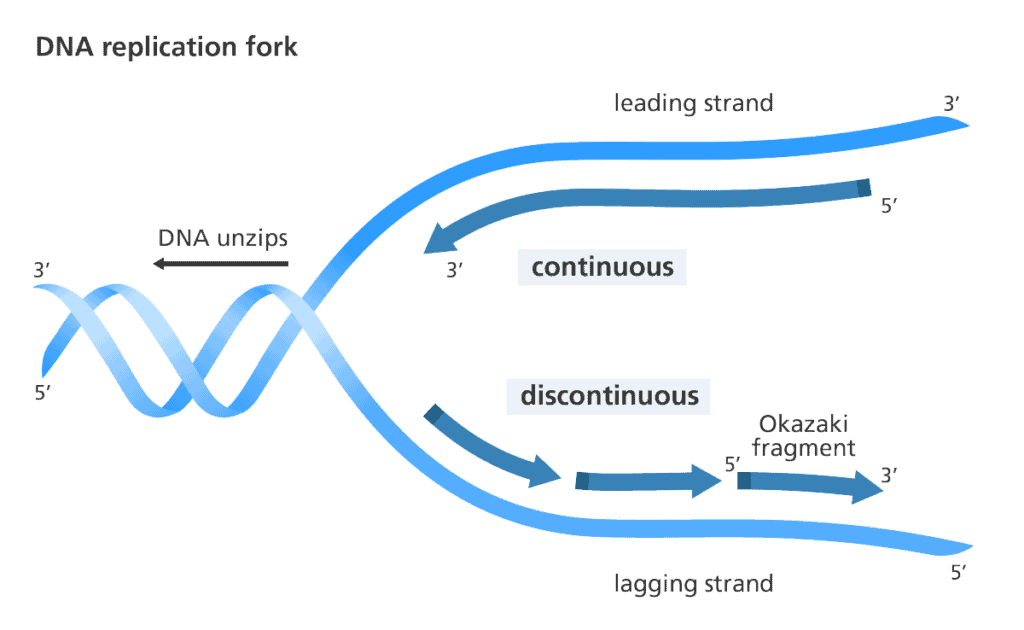What is DNA replication?
DNA, short for deoxyribonucleic acid, is the self-replicating material that is present in nearly all living organisms as the main constituent of chromosomes. It is the fundamental carrier of genetic information, present in virtually every cell in your body.
Double-helix DNA is made of two asymmetrical strands. Each strand is made of nucleotides lined up one after the other, and these nucleotides are bound to corresponding ones on the other strand to create a ladder-like structure. DNA is made up of four nucleotides — the building blocks of nucleic acids — which are composed of a nitrogenous base, a five-carbon sugar (ribose or deoxyribose), and at least one phosphate group.
Adenine (A), Thymine (T), Guanine (G), and Cytosine (C) are called nucleotides. A and G are called Purines while T and C are called Pyrimidines. According to the rules of base pairing, A always pairs with T, and C always pairs with G.
Before a cell duplicates or divides, through either mitosis or meiosis, DNA must be replicated to ensure that each new cell receives the correct number of chromosomes. This process occurs in all living organisms and is the basis for biological inheritance.
DNA replication occurs in several steps that involve multiple proteins called replication enzymes, as well as RNA. DNA replication is vital for cell growth, repair, and reproduction in organisms.
The basic steps of DNA replication are:
- The DNA double helix is unwound and separated into two strands.
- Enzymes create short RNA primers on each strand.
- DNA polymerase enzymes add nucleotides to the new strand in the 5′ to 3′ direction.
- Nucleotides are added continuously on the leading strand.
- Nucleotides are added in short fragments called Okazaki fragments on the lagging strand.
- DNA polymerase removes the RNA primers and replaces them with DNA nucleotides.
- Ligase joins the Okazaki fragments together on the lagging strand.
- The result is two identical copies of the original DNA molecule.
DNA replication steps
There are three main steps to DNA replication: initiation, elongation, and termination.
In order to fit within a cell’s nucleus, DNA is packed into tightly coiled structures called chromatin, which loosens prior to replication, allowing the cell replication machinery to access the DNA strands.
Before DNA replication can begin, the double helix structure of the DNA molecules has to be ‘unzipped.’ Helicase, an enzyme, is integral to this process, breaking the hydrogen bonds that hold the complementary bases of DNA together (A with T and C with G). The separation creates a ‘Y’ shape called a replication fork and the two single strands of DNA now act as templates for making new strands of DNA.
Next, the Single-Stranded DNA Binding Protein (SSB Protein) binds to the now single-stranded DNA, preventing the separating strands from joining again.
The two strands of the double-helix DNA are joined together by cross-bars, and twisted around. For this to work, each DNA strand runs in the opposite direction.
One of the strands is oriented in the 3’ to 5’ direction (towards the replication fork), this is the leading strand. The other strand is oriented in the 5’ to 3’ direction (away from the replication fork), this is the lagging strand.
Because the enzyme that carries out the replication, DNA polymerase, only functions in the 5′ to 3′ direction, this means that the daughter strands synthesize through different methods, one adding nucleotides one by one in the direction of the replication fork, the other able to add nucleotides only in chunks. The first strand, which replicates nucleotides one by one is the leading strand; the other strand, which replicates in chunks, is the lagging strand.
The notations 5′ and 3′ mean “five prime” and “three prime,” which indicate the carbon numbers in the DNA’s sugar backbone. These numbers indicate end-to-end chemical orientation, with the numbers 5 and 3 representing the fifth and third carbon atom of the sugar ring respectively. The 5′ carbon has a phosphate group attached to it and the 3′ carbon a hydroxyl (-OH) group. It’s this asymmetry that gives a DNA strand a “direction,” allowing for easy binding between nucleotides of the opposite strands.
It’s important to note that the two sides are replicated through two different processes in order to accommodate the directional difference.
After the formation of both the continuous and discontinuous strands, an enzyme called exonuclease removes all RNA primers from the original strands. The gaps where the primer(s) had been are then filled by yet more complementary nucleotides.
Another enzyme “proofreads” the newly formed strands in order to make sure there are no errors.
The enzyme DNA ligase then joins Okazaki fragments together, forming a single unified strand.
A special type of DNA polymerase enzyme called telomerase catalyzes the synthesis of telomere sequences at the ends of the DNA. Telomeres are regions of repetitive nucleotide sequences at each end of a chromatid, which protects the end of the chromosome from deterioration or from fusion with neighboring chromosomes. Think of shoelace caps. Telomeres are also a biomarker of aging, with telomeres shortening with each cellular division or, in other words, as you advance in age. As a cell’s telomeres shorten, it loses its ability to function normally. Basically, shorter telomeres make you more susceptible to a number of diseases, such as cancer or cardiovascular disease.
Finally, the parent strand and its complementary DNA strand coil into the familiar double helix shape. The result is two DNA molecules consisting of one new and one old chain of nucleotides. Each of these two daughter helices is a nearly exact copy of the parental helix (it is not 100% the same due to mutations).
The human genome — meaning the complete set of genes present in a cell’s nucleus — is comprised of 3 billion base pairs. Remarkably, it takes very little time for our biological machinery to copy something this exceedingly long. Every cell completes the entire process in just one hour!



